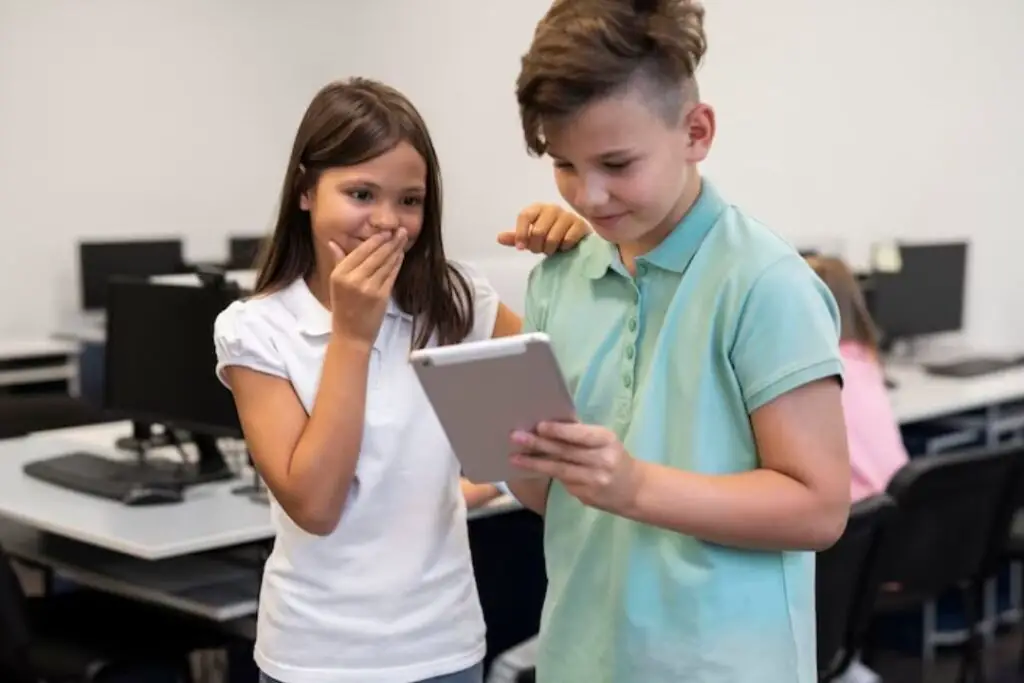It’s hardly surprising that children in today’s digital era would want to have cellphones of their own. The question of whether or not students should be allowed to bring their phones to class has been hotly debated for some time, but there are a number of good arguments in favor.
We, as parents and teachers, need to think about the positive effects of cellphones on children’s security, education, and interaction with peers.
This article will discuss the benefits of allowing students to bring mobile devices to school and how they may improve students’ ability to interact with teachers and classmates. Read on if you’re a teacher or parent who wants to learn more about how cellphones may help today’s students succeed in the classroom.
Read More: When Do Kids Start Preschool?
22 Reasons Why Kids Should Have Phones in School
1. Safety
Why Kids Should Have Phones in School? Parents and teachers place a premium on their children’s safety, and cellphones may play an important part in this. Having a way to contact parents or guardians in the event of an emergency is a major benefit of having phones available to students at school. Smartphones make it easy for them to contact their parents and inform them of their location or request assistance.
Parents may rest easy knowing exactly where their children are at all times thanks to the GPS tracking capabilities of modern cellphones. Children’s safety on the way to and from school is another area where cellphones might be helpful.
In order to travel securely, people may utilise a ridesharing service like Uber or Lyft. With these advantages, it’s easy to see how cellphones might be a helpful tool for protecting students while they’re at school.
2. Access to information
The ability to quickly and easily access a wealth of knowledge is crucial for children’s academic success, and cellphones provide this opportunity. Learning opportunities are almost limitless thanks to the internet and instructional applications available on cellphones.
Young people may rapidly get answers to their questions, have access to useful learning materials, and participate in innovative teaching strategies.
In addition, using smartphones, students may monitor their progress towards upcoming deadlines for projects, quizzes, and exams, allowing them to better plan their time and complete their work. By using applications and online resources, educators may also improve their students’ mobile learning experiences. Smartphones may greatly benefit children’s education by making a wide variety of resources more accessible to them.
Read More: What Are Parents Responsibilities, Duties And Rights
3. Communication
Why Kids Should Have Phones in School? Smartphones may be a useful tool for enhancing communication, which is crucial for children’s success in school. Kids nowadays have it much easier to get in touch with their educators and peers because to the widespread availability of messaging applications and email.
This might come in handy when they are working on group assignments or when they need to clarify anything with the instructor. Moreover, cellphones may encourage cooperation and teamwork by facilitating the exchange of ideas and materials amongst students.
Apps and platforms allow for improved communication between parents, instructors, and students, which ultimately benefits everyone involved in the educational process. Smartphones’ communicative capabilities provide for a more interactive classroom, where students may learn from one other and from teachers.
4. Responsibility and independence
Smartphones may help youngsters acquire important life skills like responsibility and independence. Children may improve their time management and organising abilities by using cellphones to manage their own schedules and homework.
Moreover, they may acquire the necessary skills for navigating the modern digital environment safely and responsibly by taking use of these resources. As an added bonus, cellphones may encourage self-reliance by removing the need for children to rely on adults for guidance and education.
Children’s long-term academic and professional achievement may be enhanced by encouraging the growth of their sense of responsibility and independence.
5. Counterarguments
Why Kids Should Have Phones in School? Of course, there are a lot of pros to allowing phones at school, but there are also some negatives to think about. One major issue is that students can be enticed to use their phones for non-academic reasons during class.
The possibility of cyber bullying and other internet safety concerns is another concern, and it may be difficult for schools to monitor and manage them. Others worry that our increasing reliance on smartphones may result in a decline in our ability to communicate and socialise with one another in person.
Third, there are worries regarding smartphone prices and availability since not all households can afford them or have consistent access to the internet. To guarantee that smartphone usage at school is good for all children, it is vital to understand these counterarguments and handle them correctly.
6. Responsible digital citizenship
Responsible digital citizenship is using technology and internet resources ethically. It’s how people use technology. With the rise of smartphones and other mobile devices, youngsters need to learn about digital citizenship.
Digital citizenship requires online safety. Youngsters should learn to guard their personal data and avoid strangers online. Cyber bullying hazards and proper reporting and response should also be taught.
Responsible digital citizenship includes digital etiquette. Youngsters should learn to behave politely and avoid inappropriate language and conduct online. Kids should also know to acknowledge others when exploiting their work or ideas.
Lastly, responsible digital citizenship requires knowing how technology affects society and the environment. Privacy and electronic waste problems should be taught to kids.
We can prepare youngsters for digital success by teaching them good digital citizenship.
7. Accelerated learning
Why Kids Should Have Phones in School? Rapid learning optimizes knowledge acquisition, retention, and application. It involves methods that improve learning.
Rapid learning requires interaction. Engaged learners retain more knowledge. Games and simulations may spark interest and inspire investigation.
Accelerated learning is also relevant. Relevance helps learners recall and apply knowledge. Hence, contextualizing learning materials and connecting them to real-life events is crucial.
Accelerated learning requires memory and recall. Spaced repetition and mnemonics, which employ acronyms or images to improve recall, may help students remember knowledge.
Lastly, rapid learning stresses feedback and reflection. Learners should get frequent feedback on their progress and performance and have opportunity to reflect on and apply what they’ve learned.
Accelerated learning may help students learn faster and prepare them for the changing environment.
8. Fosters positive change and innovation
21st-century education must promote good transformation and innovation. Learners need the abilities and mentality to navigate and influence a complicated, interconnected environment.
Creative and entrepreneurial education may promote good change and innovation. We can assist students become creative problem solvers by letting them explore their interests and develop their ideas. Entrepreneurship may teach students teamwork, communication, and leadership.
Social responsibility and community participation may also promote beneficial change via education. We can assist students develop purpose and responsibility by promoting community engagement and addressing social and environmental challenges. This may improve local and global conditions.
Lastly, critical thinking and digital literacy may promote constructive change in education. In the information era, learners must critically assess and comprehend information. Digital literacy—including online research and evaluation—can help students navigate the enormous and sometimes daunting world of online information.
We can assist students become active, engaged, and world-changers by supporting good change and innovation in education.
Read More: 50 Qualities Of A Good Parent
9. Tools
Why Kids Should Have Phones in School? Tools help you complete a job or reach a goal. These include technology, textbooks, manipulatives, and learning management systems.
Technology aids education. In the 21st century, computers, tablets, and smartphones have become essential to education. Educational applications, learning management systems, and online resources provide students access to a wealth of knowledge and enable them to interact with curriculum in innovative ways.
Education also uses textbooks and other print resources. Although technology has changed how we access and use information, print materials are still crucial to education. Textbooks and other print resources may give a complete and authoritative overview of a topic, making them ideal for structured learners.
Educational manipulative help students grasp abstract topics. In math, science, and language arts, manipulative assist students comprehend ideas and solve problems.
Ultimately, education is using learning management systems (LMS) to manage and distribute information. LMS systems let instructors build courses, measure student progress, and give feedback and help. They also help students work together.
Educators may create interesting and successful learning experiences for various learners by employing a number of resources.
10. Group work
Group work includes students working together to attain a goal. It is flexible and may be applied in many topics.
Moreover, group work boosts active learning. Active learning improves retention and higher-order thinking. It promotes self-directed and collaborative learning.
Further, it improves communication and social skills. Collaboration requires students to communicate, listen, and compromise. These talents are crucial for academic, career, and life success.
Although, it improves critical thinking and problem-solving. It helps students think creatively and solve difficulties. In short, it also helps individuals evaluate and synthesis information and learn from others. It motivates students. Working with peers typically motivates students to study and achieve.
Finally, it has numerous advantages, but it’s also difficult. It also needs students to collaborate and manage personality, learning style, and skill disparities. To assist students succeed in group work, instructors must provide clear objectives, norms, and support.
11. Memories and fun
Learning is exciting and memorable. Positive learning memories stimulate learners to continue learning. Fun and engaging learning helps students remember knowledge and enjoy learning.
Experiential learning creates favorable memories and makes learning interesting. Hands-on activities, simulations, and real-world experiences make up experiential learning. Experiential learning helps students learn, remember, and improve critical thinking, problem-solving, and communication skills.
Gaming creates pleasant memories and makes learning interesting. Gaming uses points, levels, and badges to motivate and engage learners. Moreover, gaming may make studying more fun by encouraging competition and accomplishment.
Lastly, a great classroom atmosphere makes learning interesting and memorable. Learners are more inclined to take chances and attempt new things when they feel supported and respected by peers and instructors. This may generate a positive feedback loop that encourages students to participate and learn.
Learning is about memories and enjoyment. Educators may inspire students by making learning interesting and establishing pleasant experiences.
12. Cell phones feature a built-in timer
Mobile phones are adaptable learning aids. Cell phones’ built-in timers may help students.
Timers may help students concentrate and manage time. A timer may help break up study periods. Learners may work on a task and take a break by setting a timer. Preventing burnout and boosting productivity.
Assessment timers may help students remain on track. Learners may manage their time and finish an assessment by setting a timer for each question or section.
Timers may also aid self-regulation and time management. Students may improve their time management by using a timer to measure how long they spend on each job.
Cell phone timers are useful for learners. Timer’s help students concentrate, decrease stress, and boost productivity.
13. Phones make it easy to connect with classmates
Mobile phones may help students connect with peers. Many students are used to texting, social networking, and other internet platforms. Students may remain in touch and cooperate better by utilising their phones.
Group messaging may help students connect with peers. Students may ask questions, exchange information, and work together in a group chat. Group texting may benefit learners who can’t meet in person due to schedule issues.
Social networking allows phones to interact with peers. Several colleges and universities offer social media sites or groups where students may interact and remain informed. Social media allows students to network with peers and alumni in their sector.
Lastly, phones may help students collaborate on tasks. Students may discuss ideas, papers, and project details on their phones. This may assist assure project success and unity.
Phones may help students connect with peers. Students may improve their education and make lasting relationships by utilising phones to communicate, cooperate, and network.
14. Phones help kids create memories with friends
Why kids should have phones in school? Mobile phones may help students make enduring friendships inside and outside of school. Phones can record precious moments with cameras, video, and other multimedia tools. Phones help youngsters make memories with friends:
Taking images and films: Modern mobile phones have high-quality cameras that let youngsters take photos and videos of their excursions with pals. These selfies and group photos may help youngsters recall their good days with pals.
Sharing photographs and videos: Friends and family may simply share photos and videos on social media, messaging applications, and other online platforms. This may help youngsters remain in touch with far-flung pals and preserve their memories.
Collaborative projects: Students may use their phones to collaborate on music videos, picture collages, and short films. These crafts may be entertaining and memorable ways to spend time with friends.
Apps for games and activities: Several applications let kids play games and do activities together. These applications let youngsters play virtual board games and multiplayer challenges with pals when they can’t be together.
Phones can help youngsters make memories with pals. Kids may use their phones’ capabilities and applications to document and share important events, establishing friendships and creating lifelong memories.
Do students feel safer with phones at school?
Many children report feeling more secure when using their phones at school, according to the research. In fact, 96 percent of kids surveyed by the National School Boards Association reported feeling safer with a mobile phone at school.
The most important argument is that having a phone gives students peace of mind and makes it easier to get aid in an urgent situation. A kid may use their phone to alert school officials, parents, or even the police if they saw or experienced bullying, harassment, or another harmful circumstance.
In addition, parents may use their children’s phones as a way to monitor their whereabouts and safety while they are at school. Schools may assist ease parents’ worries by providing pupils with a simple means to contact them while they are at school.
Of course, mobile phones may also be a disruptive factor in the classroom, thus several institutions have banned or severely limited their usage during class. Many students, however, believe that the pros of having a phone at school, such as the added feeling of safety it gives, much exceed the possible cons.
Conclusion
Why kids should have phones in school? Although there are some real concerns that must be addressed, it seems clear that the advantages of allowing students to bring phones to class exceed the disadvantages. Children’s access to information, the ability to communicate and work together, and the encouragement of individual responsibility and autonomy are just a few ways in which smartphones improve their overall sense of security, education, and socialization.
To ensure that smartphone usage in the classroom is both safe and beneficial, parents and teachers should collaborate to address any concerns and create standards.
We can better prepare our children for the digital world by embracing technology and mobile devices and creating a more exciting and fruitful learning environment for them.




